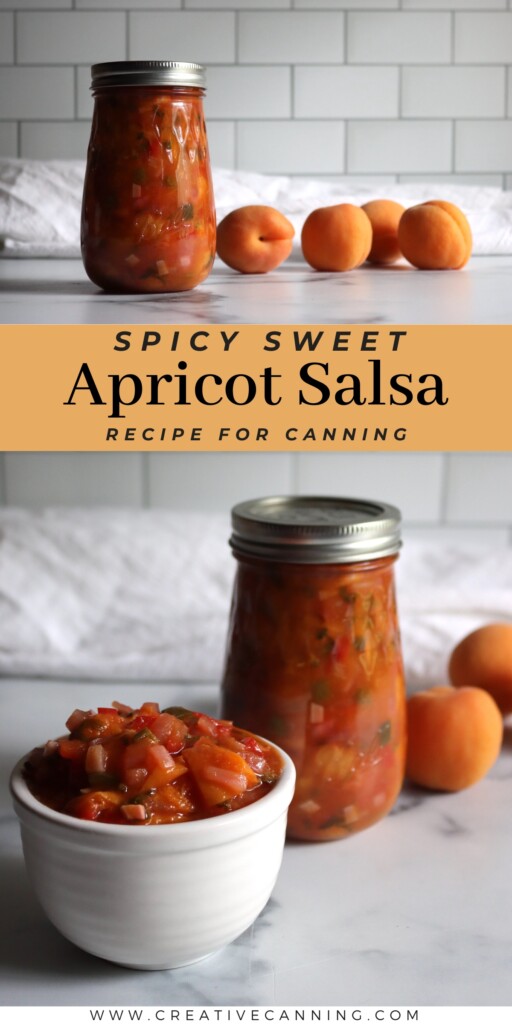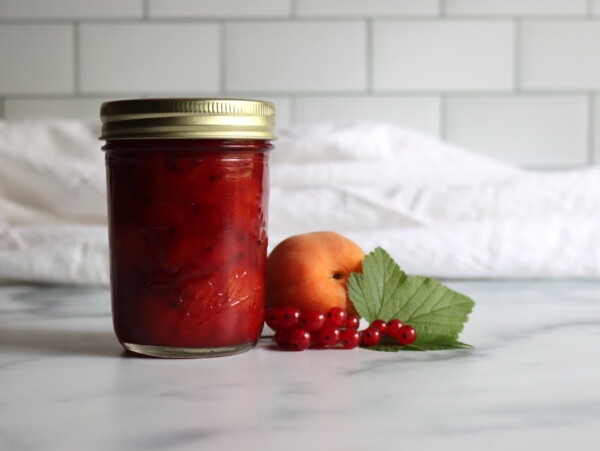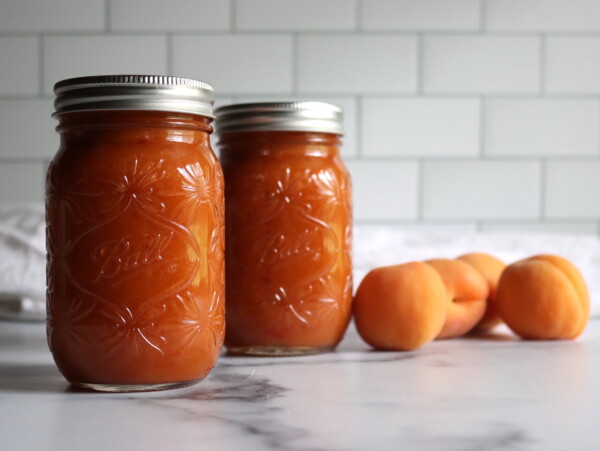This post may contain affiliate links. Please see our disclosure policy.
Apricot salsa is one of the most flavorful fruit salsas you can make—deeper and more complex than peach, pineapple or mango, and just as easy to preserve. It’s a small-batch, high-reward recipe you’ll want on your shelf every summer.
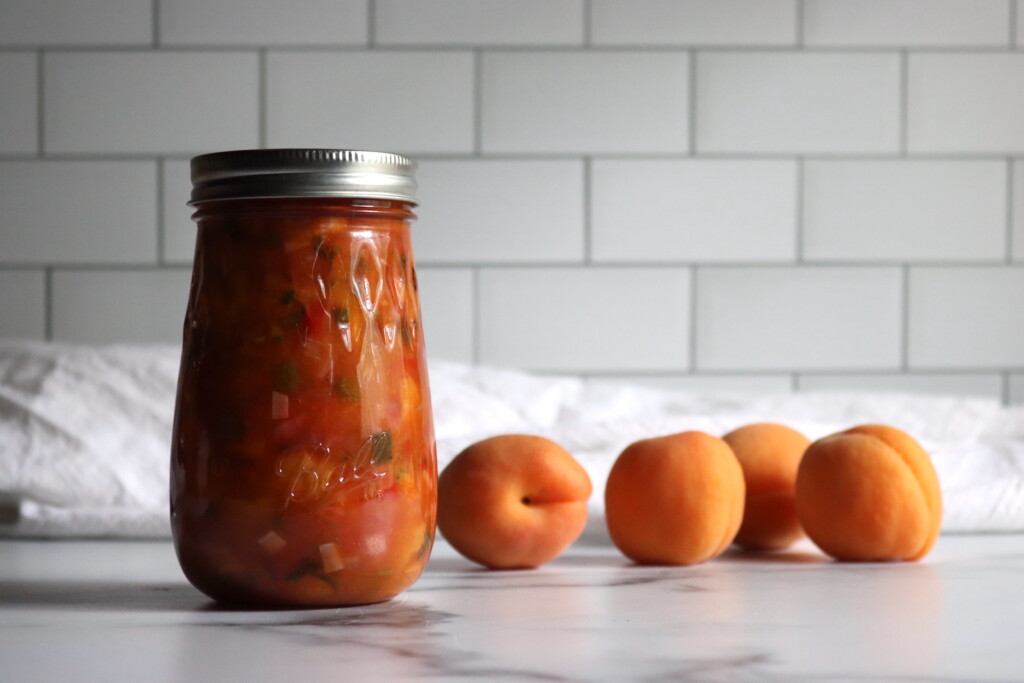
This apricot salsa is a bold, richly flavored preserve that balances the sweet intensity of ripe apricots with the savory bite of peppers, onions, and vinegar. If you’ve only ever had peach or mango salsa, apricot will surprise you—it’s deeper, tangier, and full of character. Perfect for spooning over grilled meats, fish tacos, or even serving with sharp cheese, this fruit salsa is a summer favorite worth preserving.
Based on a tested peach salsa recipe from the Ball Complete Book of Home Preserving, this version swaps in apricots for a more complex, slightly tart flavor. Since apricots don’t need peeling, prep is even faster. With plenty of acidity from vinegar, this recipe is safe for water bath canning and keeps beautifully on the pantry shelf for up to 18 months.
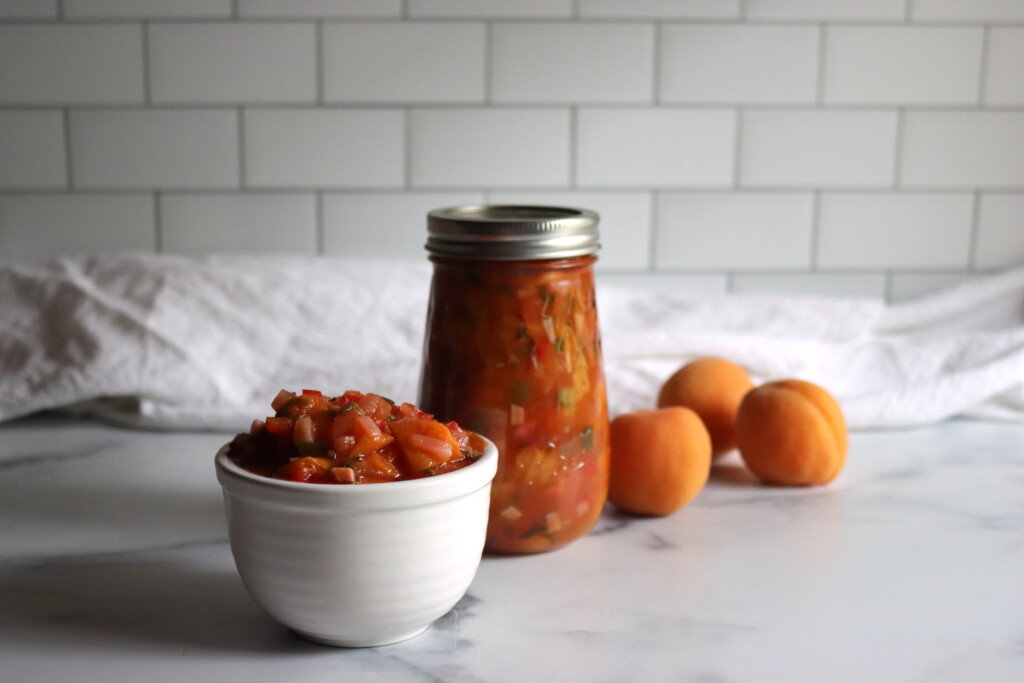
Why You’ll Love It
- Deep fruit flavor: Apricots give this salsa a richer taste than peaches.
- Quick prep: No peeling needed—just pit and chop.
- Tested and safe: High-acid recipe with vinegar makes this perfect for canning.
Can I Make Apricot Salsa Without Canning?
Absolutely! This apricot salsa is just as delicious served fresh—no cooking or canning required. Simply chop all the ingredients and toss them together in a bowl. Let it sit for 15 to 30 minutes so the flavors can meld, then serve it right away with chips, grilled chicken, fish tacos, or even spooned over a salad.
Since there’s no vinegar-based brine in the fresh version, it should be stored in the refrigerator and eaten within 3 to 5 days for best quality. It’s a great way to enjoy a quick batch if you don’t have time to can, or just want a small bowl for dinner tonight.
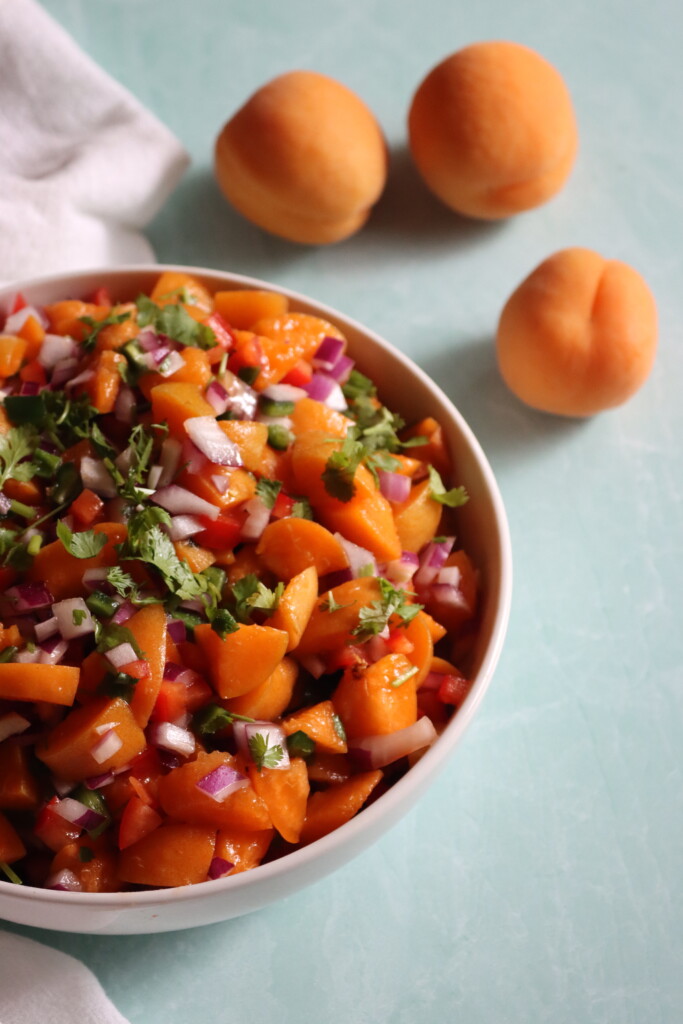
Ingredients for Apricot Salsa
This small-batch salsa makes about 4 to 5 pints. As with most fruit salsas, vinegar ensures safe acidity, and you can adjust the spice level to taste by swapping out the peppers.
- White or cider vinegar: Adds acidity for safe canning and prevents browning.
- Apricots: Ripe, pitted, and chopped. No need to peel—just halve, remove the pits, and chop into bite-sized pieces.
- Red onion: Brings a sharp, savory edge that balances the sweet fruit.
- Jalapeño peppers: Add a mild to moderate heat. Adjust by removing seeds or substituting other hot or sweet peppers.
- Red bell pepper: Adds sweetness, color, and crunch without extra heat.
- Cilantro: Optional, but adds a clean, herbal finish to the salsa.
- Honey: Rounds out the acidity and enhances the fruit’s natural sweetness.
- Garlic: Provides a punch of savory depth.
- Ground cumin: Adds warmth and a smoky undertone.
- Cayenne pepper (optional): For extra heat, depending on your spice tolerance.
If you want to customize this recipe, know that you can always substitute any type of pepper in canning recipes, so long as the total quantity stays the same. Red bell pepper and jalapenos gives you a classic salsa flavor, but this recipe also works well with habaneros for more heat, or with chipotle peppers for a smokey flavor, or with hatch green chilis for a New Mexico flavor.
Bottled citrus juice (lemon or lime) is more acidic than vinegar, and you can substitute some (or all) of the vinegar with bottled lemon or lime juice. I think this recipe works really well as written, but you can give it a bit more of a tropical flavor by substituting in 1/4 to 1/2 cup lime juice in place of part of the vinegar. Just make sure you keep the total quantity of acid the same.
(And keep in mind, while you can substitute citrus juice for vinegar, it doesn’t work the other way around in canning recipes. If you have a recipe that calls for bottled lime juice, you cannot substitute vinegar.)
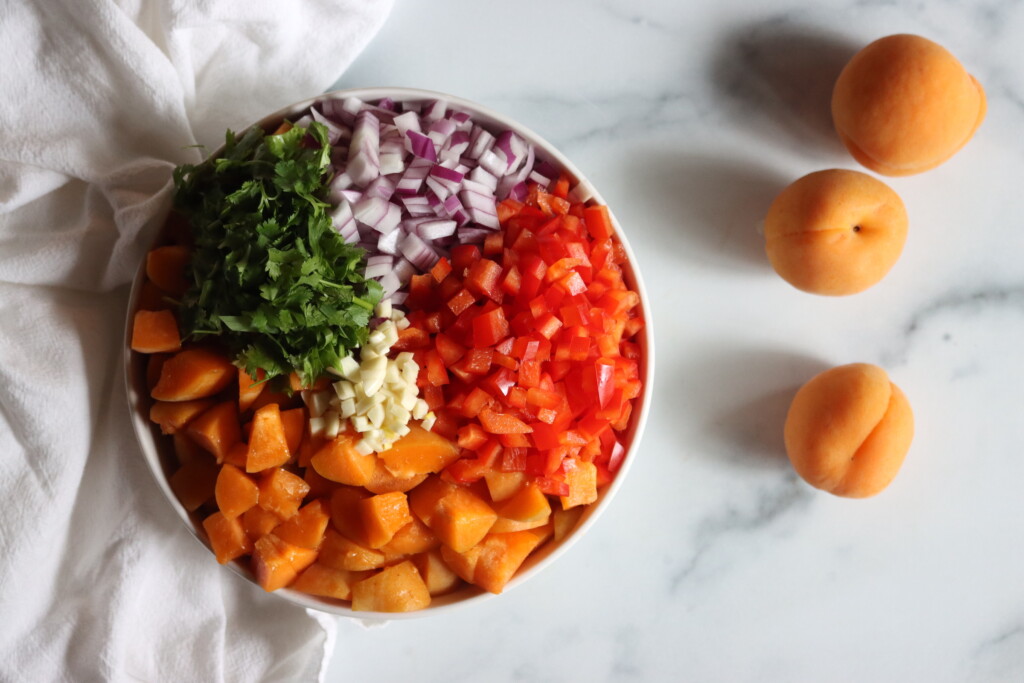
How to Make Apricot Salsa
Start by measuring the vinegar into a large stainless steel saucepan. As you chop the apricots, add them directly into the vinegar and stir to coat. This keeps them from browning and begins building the salsa’s base flavor.
Once all the apricots are chopped and in the pot, add the red onion, jalapeño peppers, red bell pepper, cilantro, honey, garlic, cumin, and cayenne (if using). Bring the mixture to a boil over medium-high heat, stirring constantly to prevent scorching.
Once it reaches a full boil, reduce the heat and simmer for about 5 minutes, stirring frequently. The salsa will begin to thicken slightly and develop a rich aroma.
Ladle the hot salsa into prepared jars, leaving ½ inch of headspace. Remove any air bubbles, wipe the rims clean, and adjust the headspace if needed. Apply two-part canning lids until fingertip-tight.
Process in a boiling water bath canner for 15 minutes, adjusting for altitude (see below). Let jars cool for 12–24 hours before checking seals. Once sealed, label and store in a cool, dark place.
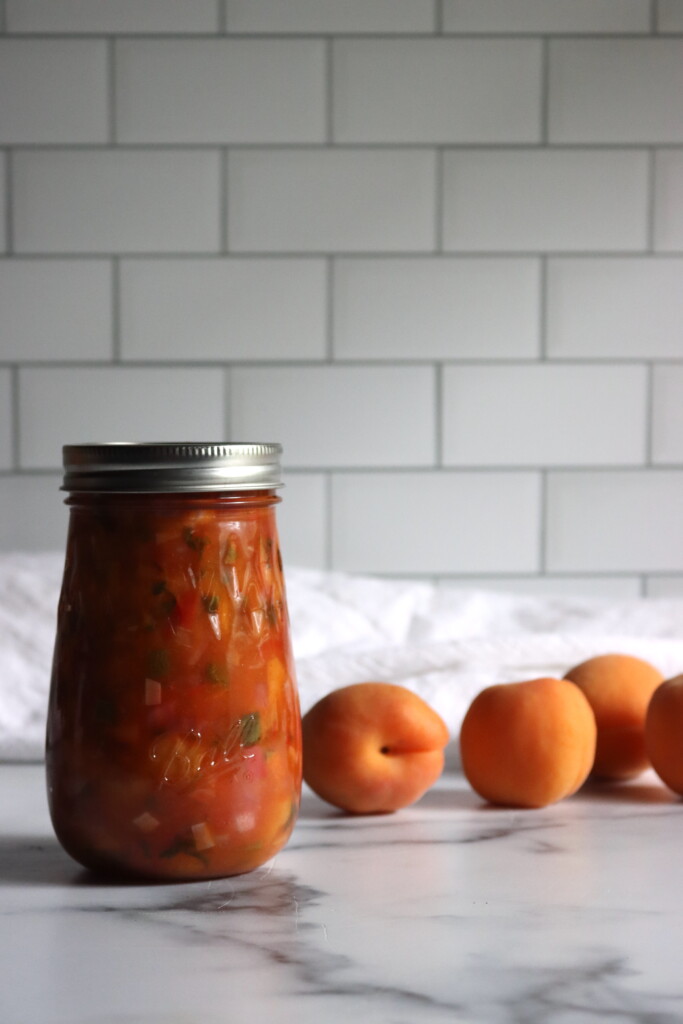
Altitude Adjustments
To ensure a safe seal, increase your processing time based on elevation:
- 0 to 1,000 feet: 15 minutes for half pints, 20 minutes for pints
- 1,001 to 6,000 feet: 20 minutes for half pints, 25 minutes for pints
- Above 6,000 feet: 25 minutes for half pints, 30 minutes for pints
Is This a Safe Salsa Canning Recipe?
Yes—this is a safe variation of a tested salsa recipe from the Ball Complete Book of Home Preserving. Swapping apricots for peaches is a simple substitution that doesn’t affect the safety of the recipe.
As always with canning recipes, do not reduce the vinegar, as it’s essential for maintaining proper acidity. You may reduce or omit low-acid ingredients like peppers, onions, or cilantro, but do not increase their total volume.
You may use any type of pepper, hot or mild, as long as the total amount stays the same. This makes it easy to adjust for your preferred level of heat.
Feel free to change the honey, spices, or herbs to suit your taste—they’re included for flavor only and won’t impact the safety of your salsa.
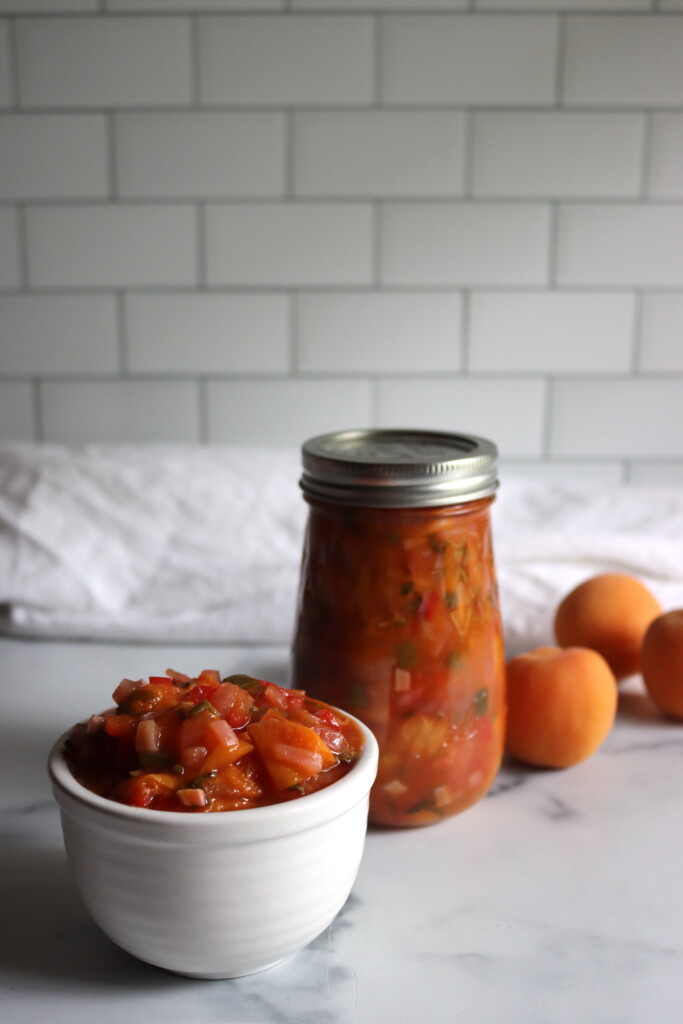
Serving Apricot Salsa
Apricot salsa brings a sweet-tart punch that pairs beautifully with both savory and spicy meals. Serve it over grilled chicken, pork, or salmon—it’s especially good alongside smoky or charred dishes.
It also makes a flavorful topping for tacos, rice bowls, or roasted vegetables.
For snacks and appetizers, try it with tortilla chips, spooned over soft cheese, or layered into wraps and sandwiches.
It even works as a chutney-style side with curries or grain-based meals, adding brightness and a touch of fruit to the plate.
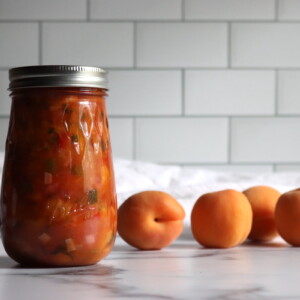
Apricot Salsa
Equipment
Ingredients
- ½ cup vinegar, white or cider vinegar, 5% acidity
- 6 cups apricots, pitted and chopped (no need to peel)
- 1¼ cups red onion, chopped
- ½ cup jalapeño peppers, finely chopped (about 4 medium)
- 1 cup red bell pepper, chopped
- ½ cup cilantro, finely chopped and loosely packed
- 2 Tbsp honey
- 1 clove garlic, finely chopped
- 1½ tsp ground cumin
- ½ tsp cayenne pepper, optional
Instructions
- Prepare salsa: Pour vinegar into a saucepan. As you chop apricots, stir them into the vinegar to prevent browning.
- Cook: Add remaining ingredients to the pot. Bring to a boil over medium-high heat, stirring constantly. Reduce heat and simmer 5 minutes.
- Can it: Ladle hot salsa into jars, leaving ½ inch headspace. Remove bubbles, wipe rims, and apply lids fingertip-tight.
- Process: Process in a boiling water bath for 15 minutes for half pints or 20 minutes for pints (adjust for altitude).
- Cool & store: Let jars cool undisturbed for 12–24 hours. Check seals, label, and store for up to 18 months.
Notes
Altitude Adjustments
To ensure a safe seal, increase your processing time based on elevation:- 0 to 1,000 feet: 15 minutes for half pints, 20 minutes for pints
- 1,001 to 6,000 feet: 20 minutes for half pints, 25 minutes for pints
- Above 6,000 feet: 25 minutes for half pints, 30 minutes for pints
Nutrition
Nutrition information is automatically calculated, so should only be used as an approximation.
Fruit Salsa Canning Recipes
Looking to keep your fruit salsa streak going? These recipes bring the same sweet-savory balance in fresh ways.
Try Peach Salsa for a lighter, summery flavor, or go tropical with Mango Salsa and Pineapple Mango Salsa. For something a bit richer, Chipotle Mango Salsa adds smoky heat, while Summer Fruit Salsa with Honey & Balsamic offers a sweet and tangy twist using peaches, pears, and tomatoes.
Apricot Canning Recipes
Apricots are incredibly versatile and can be preserved in all sorts of ways beyond salsa. There are so many apricot canning recipes!
For a classic pantry staple, make a batch of Apricot Jam or smooth, spreadable Apricot Butter. If you want to preserve whole fruit, Apricots Canned in Syrup are simple and delicious. And for dessert lovers, Apricot Pie Filling is ready to go straight from the jar into a homemade tart or cobbler.
And if you’re looking for something a bit more adventurous, Apricot BBQ Sauce is one of my favorites!
